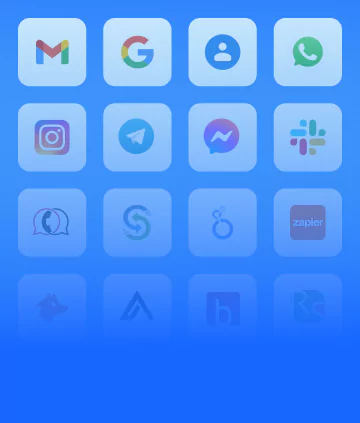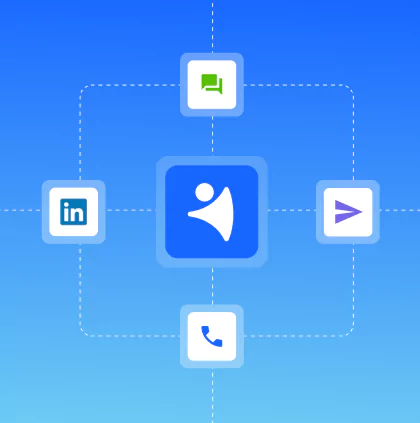You might be the slickest, most silver-tongued sales rep in the world, but cold sales calls have always got the potential to be an absolute disaster. Oh, the cringe when you catch a prospect at the wrong time, telling them the wrong things about the wrong product. To avoid any awkwardness, you should follow a script.
Cold-call (n)
an unsolicited visit or telephone call made by someone trying to sell goods or services.
1."the salesmen spend most of their time making cold calls on strangers"
Still, a cold calling script isn’t created to turn your team into robots, reeling off the same corporate spiel call after call. Instead, it sets out the boundaries to make their cold calls valuable, with the creative freedom to put their own stamp on their sales pitch.
We’ve got the lowdown on value-based selling, here!
So, we bumped heads with our fabulous customer success team (it’s called smarketing, get to know) and magicked up the hottest cold-calling best practices, a winning cold-call structure, and several cold-calling scripts on the internet right now.
8 cold calling best practices
Cold-calling has been a successful sales technique for decades. But since the Internet came along, things have changed. These days it seems old-fashioned, but the fact that less are doing it means you could be more likely to land a deal with a direct, personalised phone call as your competition clogs up customer inboxes.
Besides, the fact that cold-calling has been around for so long means we can look at all the data and learn from past successes and mistakes. Our customer success team dug deep into their memories and pulled out these eight best practices.
Don’t be afraid to go off-script.
You’re much more likely to build an organic relationship with your customer if you can relate to them on a human level. No script can help you do that; don’t be afraid to shoot the breeze with them if they sound like they fancy a chat.
Call on Wednesday.
46% more conversions happen on a Wednesday compared with Monday (CallHippo).
Call within one hour.
When a customer makes an inquiry such as an email, a download, or whatever else, sales reps should be ready to call back within the hour to make sure your product is fresh in their mind and give you the best chance of success.
Call between 4pm - 5pm or 11am - 12pm.
These are the days in which you are most likely to secure a second meeting, a demo, or even a sale.
Ask open-ended questions.
Have a list of questions prepared for your call and make sure they relate to customer's goals and pain points.
Crack a joke.
We’ve heard the old saying open with a joke! It works. Jokes help break the ice. It doesn’t even matter if it’s a bad one or a boring one about the weather, just make sure it’s not offensive!
Keep track of what works.
Cold-calling involves a lot of trial-and-error. Each customer is different, so your pitches have to be tweaked depending on who you are speaking to. Test different introductions, propositions, and closings and keep note of which ones work!
The cold truth about cold-calling is that it often ends in rejection. To maximise your chances of success you should time it properly, be fully-prepared, be open and approachable, and understand where you have gone wrong in the past.
Next, you should be prepared by knowing exactly what a cold call entails.
What happens in a cold call?
Having never done it before, you might think cold-calling simply means picking up a phone and dialing a random number and seeing if the person at the other end of the line will buy something. You’d be wrong. Worse, you’re straddling a fine line between harassment.
The cold-calling process involves a lot of groundwork before you go anywhere near a telephone. Then, when you finally do get near one, your conversation needs to be structured to make sure your cold-callee has all the information they need to make the correct decision.
> Decide who you’re going to target with calls, develop a caller persona.
You should develop an idea of who your cold-callees are before you reach out to them on a specific day; target them with specific information that’s going to guarantee cold-calling success. Imagine you’re doing a big Google Search for leads and you need to type in keywords to find them. What would those keywords be?
> Identify a list of prospects to target, research each of them.
Once you’ve decided what your cold-callee should be like, it’s time to actually find someone like them. The best place to go hunting for new leads is LinkedIn. Use the advanced search function of Sales Navigator, LinkedIn’s sales platform, to hone in on potential customers.
Find out more about LinkedIn’s subscription plans, here!
Give yourself as much chance as possible of engaging them by doing your research. Job title, company, even their full name is a good start. If you dive a little bit deeper, you’ll be able to find what motivates them. Have a look at influencers they follow, whether they’ve had any recent changes in employment, any content they’ve created, and any interests they might have.
Finally, if they’ve got a name you’ve never heard before, look up how to pronounce it. As a consumer, there’s nothing more off-putting than some fool saying your name wrong.
> Make the call.
Pick up the phone, dial the number, and put a smile on your face.
> Introduce yourself clearly.
Start by saying who you are and where you’re calling from, and ask for the person you specifically want to speak to. Keep it short and simple, but make yourself sound official. If you’ve reached a receptionist or a PA, they’re much more likely to put George Rowlands, CEO of BiscuitHunt through to the boss, rather than George, Bin Man from Manchester.
- Hello, my name is George Rowlands and I’m the CEO of BiscuitHunt. Can I speak to Jerry Sinclair please?
> Build rapport
This is potentially the hardest part. Still, building rapport is much easier if you’ve researched your cold-callee before you rang them. After you’ve asked for permission, whether they have a couple of moments to speak to you, try asking an open-ended question. This is where the answer can’t be yes or no, is the first thing they teach you in conversation-making class.
- I hope I haven’t caught you at a bad time. Congratulations on the Ballon d’ Biscuit Award, Jerry. How’s the new found fame treating you?
> Give your value proposition; position yourself.
After the trivialities are finished, your cold-callee is probably going to ask why you called. This is your single chance to shine and really make them dig both you and your product. Again, your research comes in handy here, because the first thing you should tell them is about them.
- Yes, Brian Potter at Phoenix Biscuits referred me to you. He said you were looking for office biscuit solutions for your large team?
Use this structure to learn more about how you can help your prospect. This is a cold call, after all, and you don't know much about your cold callee. Listen out for a gap in their process that your product could fill.
> Close
If you don’t organise another meeting, in-person or otherwise, your cold call has failed. Be polite, thank them for their time, and don’t take it to heart if it’s a no. There’s always the next call.
- Are you free for another call next week, Jerry?
Suggested read: How to conduct a sales discovery call
Cold call script templates
The following templates have been put together based on our own customer success team’s experience of cold calls. There’re infinite different situations in which you might cold call someone, and we obviously can’t predict what’s going to happen once your cold callee picks up the phone. The following templates should serve as boundaries for the kinds of things you can say to your cold callee in the different situations you might find yourself in.
THE GATEKEEPER
You: Hello, can I speak to [name A] please?
Them: Hello, this is [name B], I’m [name A]’s PA here at [company]. Can I ask what your business with [name A] is?
You: Actually, [name A] is looking for a [product] and he has made an inquiry with us. Maybe you have heard about our [product]. I’m [name] and I work for [company].
Them: Oh yes. [name A] mentioned that today. Would you like me to put you through?
You: That would be wonderful, thank you very much for your help [name B].
THE NAMEDROP
You: Hello, am I talking to [name]?
Them: Yes, this is [name]. Who’s this?
You: [name] from [company] referred your name for our services. He thinks you are a great fit for our [product] and highly recommended you to us. Do you have a minute to discuss further?
Them: Of course, tell me more!
THE VOICEMAIL
You: Hello, [name]. This is [name] from [company].
I’m calling to tell you about a few ideas I have for improving [process] in your company. I wanted to see if you could find some time to have a little talk with me about it. It shouldn’t take long. If you’ve got a second, give me a call on [number].
Again, that’s [name] from [company] and my phone number is [number].
Thanks, speak soon.
THE CHANNEL MIXER
You: Hello. Am I speaking to [name] from [company]?
Them: Yes, speaking.
You: This is [name] from [company]. I know you have been following our blogs and daily newsletters for a long time. Are you liking the content so far?
Them: Oh yes, absolutely. Your content is red hot.
You: Well, we took a look at your company over the weekend and our research showed that your company could be looking at a [number] increase on its productivity with our product. Is that something you want to hear more about?
Them: Oh yes, absolutely.
THE INBOUNDER
You: Am I talking to [name] from [company]?
Them: That’s me. How can I help?
You: You recently signed up on [website], and I wanted to find out how exactly we can help you. Is this a good time?
Them: Oh yes. Basically, we have a [problem] that needs solving. We need [feature], [feature], and [feature].
You: Alright. I think [product] would be perfect for you because we provide [feature]. I’ll tell you what though, you won’t learn much with me just telling you about it on the phone. Let’s book a demo and I’ll show you everything there.
Them: That sounds perfect. How’s Monday at 11AM for you?
You: Definitely.
THE SHORT AND SWEET
You: Good morning. I’m [name] calling from [company]. We’re offering some great [benefits] on [product]. I’m wondering if you’re interested in them?
THE VALUE
You: Hi is this [name]?
Them: Yes this is [name]. Who’s this?
You: This is [name] from [company]. I’m calling organisations in [industry] to see if they’d benefit from our solution. To put what we do in a single sentence, we [function]. Is this something that would be of interest to you?
THE MISSION
You: Hi [name], this is [name] from [company]. I’ve made it my mission to help [number] people achieve [goal] by the end of the month. I believe I can help you achieve [goal] as quickly as possible. Is this something you’d be open to exploring with me.
Cold-calling is a cut throat world. Some clients will hang up before you’ve had a chance to say hello; most won’t even answer their phone. For the ones that you do manage to get on the line, it’s important to be prepared. Do your homework and have written notes on each cold-callee, smile, and be polite.
If that still doesn’t work, it’s probably best to check out our sizzling-hot cold emailing guide and give that a go instead.




















 product experts — let's find the best setup for your team
product experts — let's find the best setup for your team